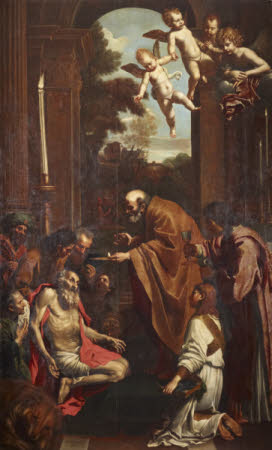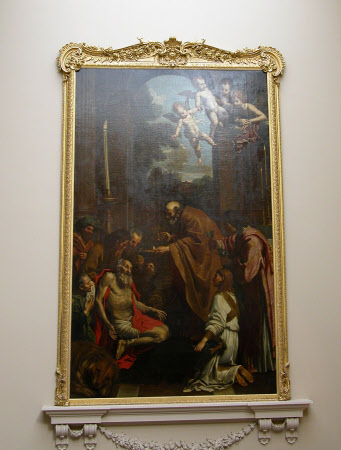The Last Communion of Saint Jerome (after Domenico Zampieri Domenichino)
Juan Antonio Ribera y Fernandez (1779-1860)
Category
Art / Oil paintings
Date
1808 (signed and dated)
Materials
Oil on canvas
Measurements
4190 x 2560 mm (E)
Place of origin
Paris
Order this imageCollection
Ickworth, Suffolk
NT 851767
Caption
Saint Jerome, ninety-three years old and on the point of death, is taking his last communion surrounded by his disciples, including Saint Paula. A priest offers the Eucharist wafer with the thumb and forefinger of his left hand and the paten between his fore and middle fingers whilst he wafts his right hand away from his body. Jerome’s customary lion, which he befriended in the wilderness, lies forlornly in the left corner. It is an unusual scene of the saint related in the apocryphal letters of the church historian St Eusebius - also Jerome’s name. The original altarpiece is by the Bolognese painter Domenichino who was inspired by his master Agostino Carracci’s 1592 depiction for the Certosa in Bologna. It was painted for the Congregation of Saint Jerome of Charity for the church of San Girolamo della Carità in Via Giulia in Rome, between 1611 and 1614 and is now in the Vatican Museum. It was looted by Napoleon, and was in Paris until 1815 when this version was copied for Joseph Bonaparte, when King of Spain, by Juan Antonio Ribera, in 1808. It is possible that Lord William Hervey acquired it in Madrid in the 1830s.
Summary
Oil painting on canvas, The Last Communion of Saint Jerome (after Domenico Zampieri Domenichino) by Juan Antonio Ribera y Fernandez (1779-1860), signed and dated: J A Ribera Español 1808. A full size copy after Domenichino. Saint Jerome, bottom left, in loin cloth and red wrap, surrounded by male figures in dark robes; lion at his feet. Central figure in russet cloak with highlighted bald head, offers Host. Five other figures, bottom right corner - standing figure in brown, kneeling figure in white. All grouped before high archway through which landscape is seen. Tall candle at left of archway. Group of cherubs in top right corner. This is a full size copy of Domenichino's famous painting, of 1614, in the Vatican, which was looted by Napoleon and remained in Paris until 1815. According to the 1st Marquess of Bristol's manuscript list of paintings at Ickworth this version was painted for Napoleon's brother, Joseph Bonaparte, when King of Spain by the artist who was was a pupil of Bayeu and David and taught at the Madrid Academy.
Provenance
According to Lord Bristol's list it was copied for Joseph Bonaparte, when King of Spain, by Juan Ribera whilst the original altarpiece by Domenichino was in Paris, in 1808. If, as it may have been, this picture was despatched to Madrid, it is possible that it was acquired there in the 1830s by Lord William Hervey. This would tend to give greater credence to the speculation that the Velasquez may have been bought in Spain by this member of the family; thence by descent to Rear Admiral Frederick William Fane Hervey, 4th Marquess of Bristol (1863-1951), on whose death valued for probate; accepted in lieu of tax by HM Treasury, and transferred to the National Trust in 1956
Makers and roles
Juan Antonio Ribera y Fernandez (1779-1860) , publisher after Domenico Zampieri Domenichino (Bologna 1581 - Naples 1641), publisher
References
Cropper 2005 Elizabeth Cropper, The Domenichino Affair. Novelty, Imitation and Theft in Seventeenth-century Rome, Yale, 2005 Spear 1982 R. E. Spear, Domenichino, New Haven and London, 1982, no. 41 a., p. 176 and no. 41, pp. 175-78 and pl. 135


